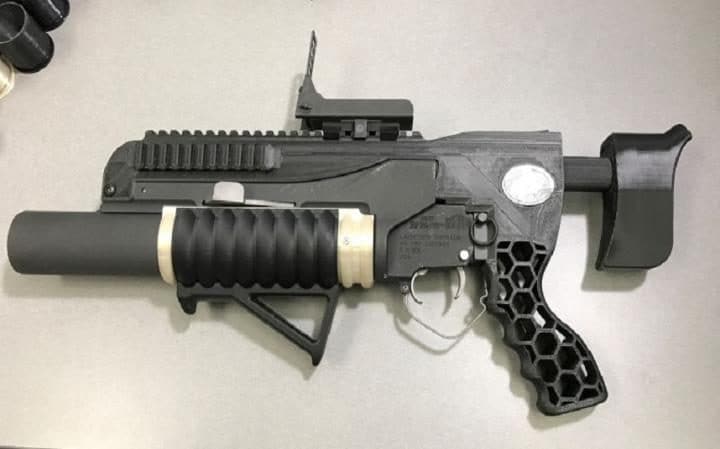US military printed RAMBO grenade launcher

3D printers are now used everywhere: in everyday life, science, medicine, at work. Work with such devices and the military. And not only for the creation of any spare parts for weapons or equipment that are not in stock and urgently needed. Recently, the US Army presented a grenade launcher, almost all of the elements of which are printed on a laser sintering plant. It shoots this weapon with grenades, the cases of which are also printed. True, the material is not plastic, but metal.
RAMBO (Rapid Additively Manufactured Ballistics Ordnance) is a modified model of an M203 grenade launcher with a shoulder butt and pistol grip. M203 is usually used with an M16 or M4 rifle, it is fixed under the barrel.
The printed grenade launcher consists of 50 parts. Everything, except fixture and springs is printed . The barrel and receiver are aluminum, they were made by direct laser sintering. This technology involves the creation of a three-dimensional model that is digitally processed to be divided into thin layers. Their thickness corresponds to the layers applied by the printing device. The final file is used as a whole set of drawing instructions for the printer.
')
Laser sintering uses metal powder, which is heated by fiber-optic lasers with a power of about 200 watts. Some “printers” use lasers with increased power and speed of movement of the laser beam for faster work. The metal in the powder is fed into the working chamber in the volume required for the deposition of one layer. After the layer is ready, the process is repeated. Print resolution with direct laser sintering is very high - about 20 microns. In household 3D printers, where FDM / FFF technology is used, the resolution is about 100 microns. The trigger and the head are also printed, the source material was grade 4340 steel.

Metal parts of a grenade launcher created by direct laser sintering technology. In the photo there is no receiver and trunk. Source: US Army Acquisition Support Center
Laser sintering is a slow process. So, it took about 70 hours of printer operation and another 5 additional hours for final processing to create a barrel with a trigger mechanism and a receiver. The barrel was cleaned with abrasive and coated with a special reinforcing compound.
Despite the relatively long time to create a grenade launcher, the military was satisfied with the technology of making weapons. The fact is that the laser sintering plant is relatively small. Installing and running it is a matter of a couple of days. But to create a weapons factory is a much more difficult task, the implementation of which will take months and hundreds of thousands, or even millions of dollars.

And this is a training grenade, which was also printed out on a printer.
Grenades for the created weapons are also printed on the laser sintering installation. To create them, powdered aluminum and nylon with fiberglass were used.
The military developed and tested the RAMBO last year, in October 2016. After 15 rounds of damage to the grenade launcher, it was not noticed, the weapon turned out to be reliable. The difference in the initial velocity of the projectile was about 5% with the speed of an ordinary grenade fired from the barrel of a grenade launcher produced in the standard way.
Specialists who participated in the project, mention only one problem that arose during the creation of a grenade launcher and its projectiles. The point is that the first version of the grenades was quite fragile, and the shells of some of them cracked. To remedy the situation, engineers modified the 3D model of the grenade in the software, making the walls thicker. After this, the problem disappeared - the grenade body stopped cracking.
According to the military, weapons of this type can be created online at outposts. You can either print the weapon itself or its parts if they are out of order. Probably, this experience can be transferred to the creation of weapons of a different type - rifles, carbines, mortars, etc. The developers say that the new technology allows you to create and test prototypes of a new weapon in a matter of days instead of months. “Designing a new type of weapon that was previously impossible to create is a matter of several months,” experts say. If earlier weapons developers needed a lot of time, a team of employees and a large amount of money, now you can do with much smaller forces, at the same time reducing financial costs. Unfortunately, the cost of the project was not announced.
Printing weapons is no longer news. Over the past few years, professional gunsmiths and firearm enthusiasts have repeatedly presented projects of various types. For example, this is a plastic Liberator pistol, a metal Reason pistol , a Shuty MP1 semi-automatic pistol. After the Liberator project began to gain popularity, in the United States and other countries it was proposed to ban or restrict the manufacture of weapons of this type. Restrictions relate, in particular, to the storage and exchange of files for 3D models for firearms.
Source: https://habr.com/ru/post/402207/
All Articles